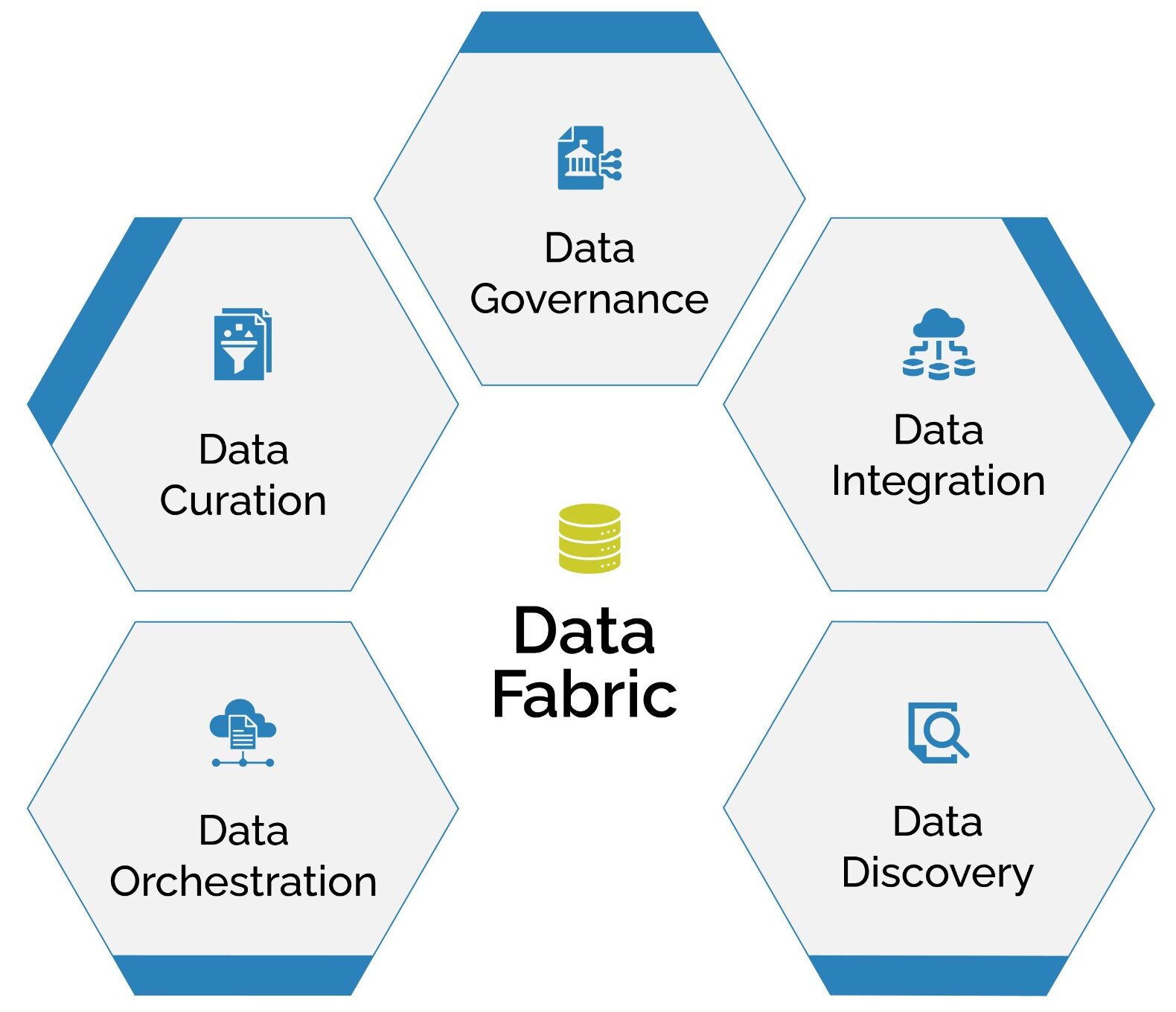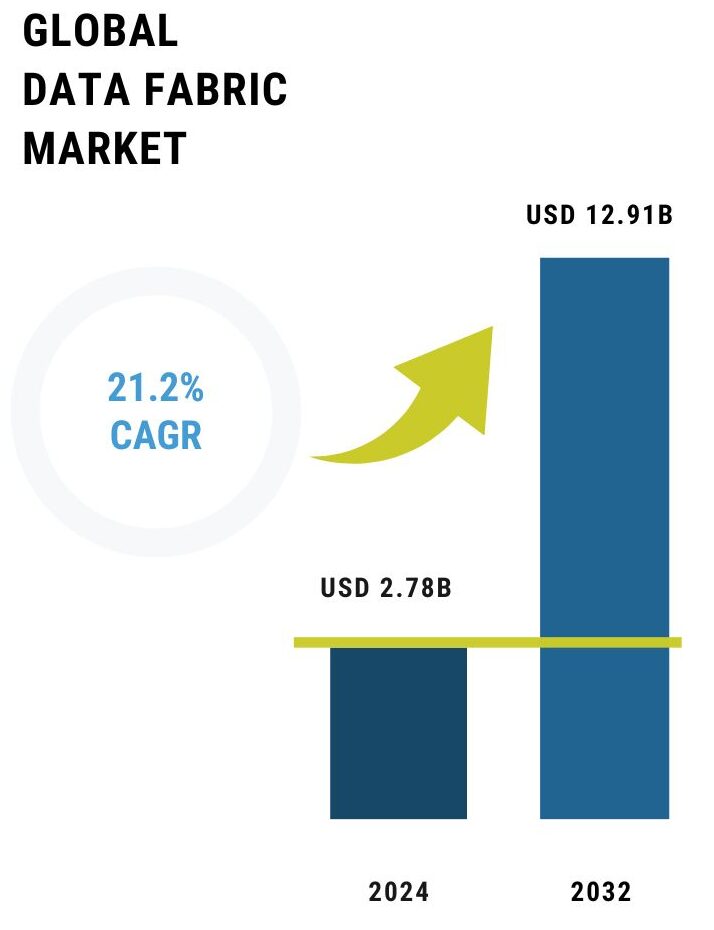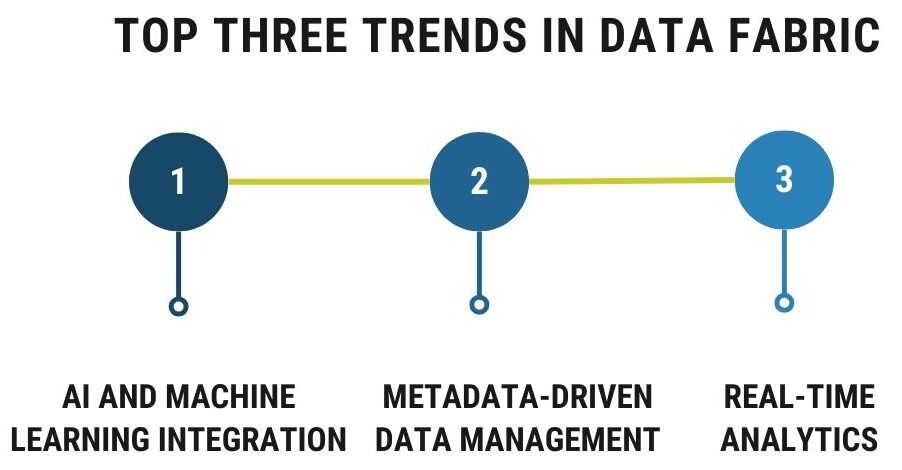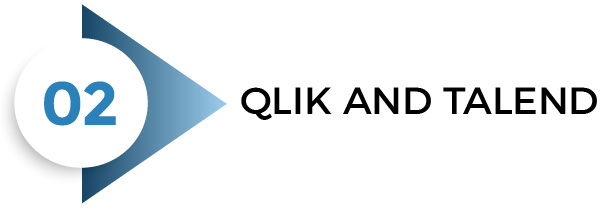As per recent market research data available, nearly 80% of global data will be unstructured, as we get into 2025—scattered across disconnected systems, buried in silos, and locked away in legacy architectures.
This statistic underscores a growing need in the digital age: businesses are overwhelmed by data but struggling with insights. Despite investing billions in data systems, most organizations face challenges to make sense of their information, compromising business decisions, hampering agility, and leaving massive value untapped. In a world where real-time insights and AI-driven decisions separate leaders from laggards, the question is no longer whether businesses need better data management—it’s how quickly they can achieve it.
Enter Data Fabric—a revolutionary concept coined in 2016 by Forrester’s Noel Yuhanna that’s evolved from buzzword to business imperative. By weaving disconnected data into a unified, intelligent network, Data Fabric empowers businesses to eliminate silos, unlock hidden insights, and fuel decision-making processes with 50% less reliance on human intervention - an insight by Global Data Excellence.
Data Fabric acts as the central nervous system of an organization’s data, seamlessly integrating cloud, on-premises, and hybrid environments into a unified architecture. It modernizes data flow through standardization, automation, and intelligence, enabling interoperability across platforms.
For enterprises, Data Fabric is transformative, enabling:
- Real-time insights for faster, smarter decisions.
- Silo elimination to unlock hidden value in legacy systems.
- AI-driven governance for high data quality.
- Knowledge graphs to establish deeper data relationships.
- AI/ML integration for predictive analytics.
More than a framework, Data Fabric is a game-changer—reshaping how enterprises leverage data to drive growth, integrate AI, and outpace competitors in a rapidly digitizing world. Beyond operations, Data Fabric delivers strategic advantages, making it a cornerstone for modern data management.
From Fragmented to Unified: How Data Fabric Revolutionizes Enterprise Data Management.
Picture an organization as a sprawling city. The data—generated across departments, systems, and platforms—is like countless roads and intersections. But without a centralized map, traffic clogs. Decision-makers can’t navigate efficiently. This is what data silos do—they isolate information, making integration and analysis cumbersome.
Historically, enterprises turned to data lakes or data meshes to consolidate and manage data. While these approaches brought improvements, they fell short of creating a truly interoperable system—one that seamlessly connects, processes, and delivers insights across diverse sources.
This is where Data Fabric comes in. It’s not just about storing data; it’s about weaving a connected network that makes data discoverable, accessible, and actionable—in real time. Enterprises require architectures that are:
- Flexible to adapt to evolving data needs.
- Scalable for growing volumes.
- Secure to meet compliance and privacy standards.
Data Fabric excels in addressing these needs. It ensures real-time analytics, enabling industries like finance, healthcare, energy, logistics, and manufacturing to act instantly, avoiding lost revenue or poor customer experiences.
With hybrid and multi-cloud strategies on the rise, Data Fabric’s interoperability bridges gaps between legacy systems and modern platforms—delivering seamless integration without disruption.
Within the HLS space, take the Cleveland Clinic as an example. It implemented Data Fabric to synchronize data flows between its EHR systems, external labs, and imaging centers. This integration enables real-time data exchange, ensuring that lab results and imaging reports are instantly available within patient records. Physicians can make faster, data-driven decisions, reducing delays in diagnosis and treatment.
Similarly, the National Institutes of Health (NIH) uses Data Fabric to aggregate clinical trial data scattered across multiple research centers and platforms. By creating a unified data layer, NIH researchers can query datasets, run advanced analytics, and derive insights without moving or duplicating data. This accelerates drug development and therapeutic discoveries, improving collaboration across research teams.
These examples highlight how Data Fabric eliminates data silos, streamlines data access, and empowers AI-driven decision-making—delivering faster insights, improving efficiency, and transforming patient care in healthcare and life sciences.

Data Fabric Market Growth and Trends
The global data fabric market, valued at $2.78 billion in 2024, is projected to reach $12.91 billion by 2032 at a 21.2% CAGR, as stated by Fortune Business Insights. Growth is driven by North America’s early adoption of advanced data solutions and Asia Pacific’s rise in digitalization initiatives and tech startups offering innovative platforms.

What’s driving this growth?
- Complex Data Environments – Rising data volumes demand integration solutions.
- AI and Automation – AI-driven management automates workflows, enabling predictive analytics.
- Real-Time Insights – Businesses require instantaneous data access for better decisions.
- Cloud Adoption – Hybrid and multi-cloud strategies drive demand for scalable frameworks.

In the rapidly evolving landscape of data management, Data Fabric has emerged as a pivotal architecture, enabling organizations to seamlessly integrate and manage data across diverse environments. This unified approach not only enhances data accessibility but also drives significant business value.
Who’s Leading the Charge? Key Players in the Data Fabric Space
The data fabric market is led by IBM, SAP, Microsoft Azure, AWS, Oracle, Cloudera, Talend, and TIBCO. These companies are investing in AI-powered governance frameworks and scalable solutions while leveraging partnerships and acquisitions to expand capabilities.
- IBM – Focuses on AI-enhanced governance and real-time insights for decision-making.
- Microsoft Azure – Integrates big data and data warehousing for unified management.
- Oracle – Offers end-to-end data integration for a unified data view across environments.
Collaborations between key players and specialized firms are on the rise, focusing on developing modern data management solutions:
- EY and Microsoft – A $15 billion collaboration to develop data fabric platforms for regulated industries, enabling seamless cloud-based transformation.
- ServiceNow and Cognizant – Partnered to bring Workflow Data Fabric to market, enabling AI-powered data actions and streamlined integrations.
Accelerating Investments and M&A in the Data Fabric space
The data fabric sector is witnessing accelerated M&A activity as companies enhance AI-driven analytics, data integration, and real-time insights to address growing data complexities. With the market projected to grow from $2.77 billion in 2024 to $12.91 billion by 2032 (CAGR 21.2%), strategic investors are acquiring data-focused platforms to strengthen scalability, compliance, and AI capabilities.
The following acquisitions illustrate how leading players are leveraging strategic investments to scale their data fabric capabilities, unlock new growth opportunities, and deliver advanced solutions in an increasingly data-driven economy.

Altair, a global leader in computational intelligence, headquartered in Troy, Michigan, with over 3,400 employees has acquired Cambridge Semantics, a modern data fabric provider and creator of one of the industry’s leading analytical graph databases, based in Boston, Massachusetts, with approximately 53 employees. This acquisition enhances Altair’s capabilities in knowledge graph technology, enabling organizations to integrate structured and unstructured data into unified views for AI-driven analytics and decision-making. The integration of Cambridge Semantics’ technology into Altair RapidMiner strengthens data governance, virtualization, and discovery, providing enterprises with scalable tools to build AI-powered ecosystems and optimize data management workflows.

Qlik, a global leader in data integration and analytics, headquartered in King of Prussia, Pennsylvania, with 2,000+ employees, has acquired Talend, a data integration and quality solutions provider, headquartered in Redwood City, California, with 1,000+ employees. This acquisition strengthens Qlik’s ability to deliver end-to-end data solutions, combining data integration, transformation, analytics, and governance. The integration addresses data fragmentation challenges, providing enterprises with trusted, scalable data platforms to support AI-driven insights and decision-making. With complementary capabilities, Qlik and Talend offer expanded product portfolios, enhanced support, and increased R&D investments, enabling customers to eliminate inefficiencies, reduce costs, and accelerate digital transformation.

Denodo Technologies, a data virtualization company headquartered in Palo Alto, California, with approximately 770 employees, secured a $336 million Series B investment from TPG Growth, the growth equity arm of TPG Inc. Denodo pioneered data virtualization to enable organizations to access and analyze disparate data sources without copying or relocating data. Denodo Enterprise Data Fabric platform provides governed, self-service access to over 200 data systems, including databases, cloud object stores, and streaming data via REST and GraphQL APIs. Denodo’s approach has delivered significant results, including a 400% ROI, and earned it premier clients such as Albertsons, Gilead, Logitech, Seagate, T-Mobile, and Volvo. The Series B funding will fuel global expansion and product innovation, solidifying its position as a leader in data management and data fabric solutions.
Looking Ahead
Modernizing data infrastructure is a strategic necessity. Data Fabric offers a transformative framework to unify fragmented data, deliver real-time insights, and drive operational efficiency. However, realizing its full potential requires a phased, strategic approach aligned with business goals and investment strategies. The projected growth of the Data Fabric market and the surge in M&A activity highlight its strategic importance across industries. Enterprises adopting this framework today are poised to lead in agility, scalability, and innovation.
SA Global Advisors (SA), a leading global investment banking firm specializing in strategic investments and M&A transactions in the Technology, Media, and Telecom (TMT) sectors, empowers entrepreneurs and investors to capitalize on this transformation. By providing growth capital and facilitating partnerships and acquisitions, SA supports businesses in realizing their vision for the digital age. Embracing Data Fabric isn’t just a technological upgrade—it’s a foundation for sustainable growth and market leadership. In today’s data-driven world, success is about partnering with visionary investors to unlock growth, scale, and competitive advantage.
To share feedback on this blog or discuss transaction opportunities, please reach out to us at [email protected].
Newsletter Subscription
SubscribeREAD NEXT
- Smart, Connected, and Autonomous: The Role of Digital Engineering in Next-Gen Vehicle
- Opportunities in Generative AI: Fueling Innovation and Strategic Growth
- Digital Engineering: Powering Innovation & Growth Across Mission-Critical Industries
- The Modernization Trinity: Unlocking Growth with Cloud, App and Data Modernization
- Thriving in the ServiceNow Ecosystem: Strategies for Growth 2.0
Subscribe
Stay current with our latest insights in your inbox.


